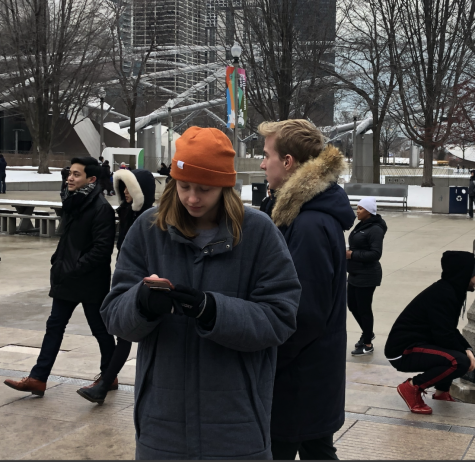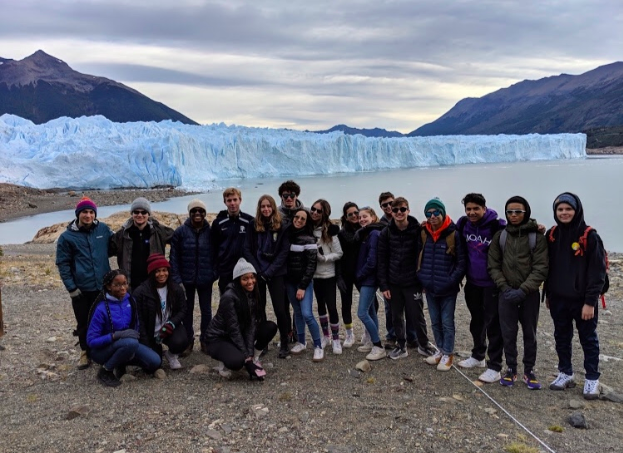Don’t Cry for Me, Argentina
The students on the trip pose in front of the glaciers in Patagonia.
Before spending 12 days there over Spring Break, none of the 19 students, myself included, knew the full extent of what Argentina had to offer geographically, culturally, or historically.
The trip’s first stop was Buenos Aires, an endlessly colorful and vibrant city, home to some of the best dulce de leche filled churros in the world. Highlights from the stay there included visiting the majestic graveyard across from the hotel where the city’s wealthiest, such as Evita Perón, lie buried, eating a healthy plate of cow stomach and intestines for lunch, exploring La Boca, one of the city’s oldest and most radiant neighborhoods, and visiting the cultural center and market in Recoleta.
After a couple days, we flew north to visit the Iguazú Falls, the widest waterfalls in the world. We were fortunate enough to see the breathtaking, and seemingly infinite, waterfalls from several different angles including from the Argentinian side, Brazilian side, and a boat which led us directly under one of the smaller waterfalls. Besides being drenched by the stunning waterfalls in Iguazú, we also went on scenic hikes in the area and became familiar with coatis, animals like raccoons but with sharper claws and less fear of humans.
Our next stop, after a full day of flying and being stuck in the airport, was El Calafate, located in the Southern region of the country known as Patagonia. Both days we got up bright and early, or rather, dark and early as the sun hadn’t risen yet, before heading into the national park. The first day, we took a small boat ride across the indescribably blue water to a small cove where we got to walk on the glacier. It was incredible. After a couple hours of trekking in crampons, metal spikes meant to prevent you from slipping on the ice, we hopped on the boat back to the other side of the bay where we saw a full view of the glacier and chunks of ice falling off it. The next day, we took a 5 hour boat ride towards a different glacier, encountering several icebergs and extremely cold winds along the way. I doubt any of us had ever seen ice so beautiful or water so blue in our lives, and I apologize that I am at a loss for words on how to describe it other than stunningly gorgeous.
Following El Calafate, we returned to Buenos Aires for a few more days. We continued to explore the city, visiting the world’s most beautiful bookstore, a tango show, and a famous pizzeria. One of the less uplifting moments, however, was when we visited EMSA, the Higher School of Mechanics of the Navy in Buenos Aires where, under the dictatorship of the National Reorganization Process between the years 1976-1983, 5,000 Argentine citizens were tortured and killed by their own government. Among them were hundreds of pregnant women who were tortured and then killed after giving birth. Their children, who the mothers never got to see, were given to families associated with the dictatorship. ESMA was not the sole institute like it during that period. According to history.com, 30,000 people disappeared during the 7 year period.
In addition to learning about Argentina’s history, in our last several days we also visited El Tigre, a small town built on the Paraná Delta, and a Gaucho ranch where we got to ride horses and listen to some music.
During our time in Argentina, I believe I heard Spanish teacher Gabriel Rubinson say “this is my favorite part” about a hundred times all across the country, and I have to agree with him in every single instance. It was incredible.

Tessa Marker '21 has been a staff writer for the Polygon since her freshman year and has enjoyed taking on more responsibility as a News Editor last year...












































